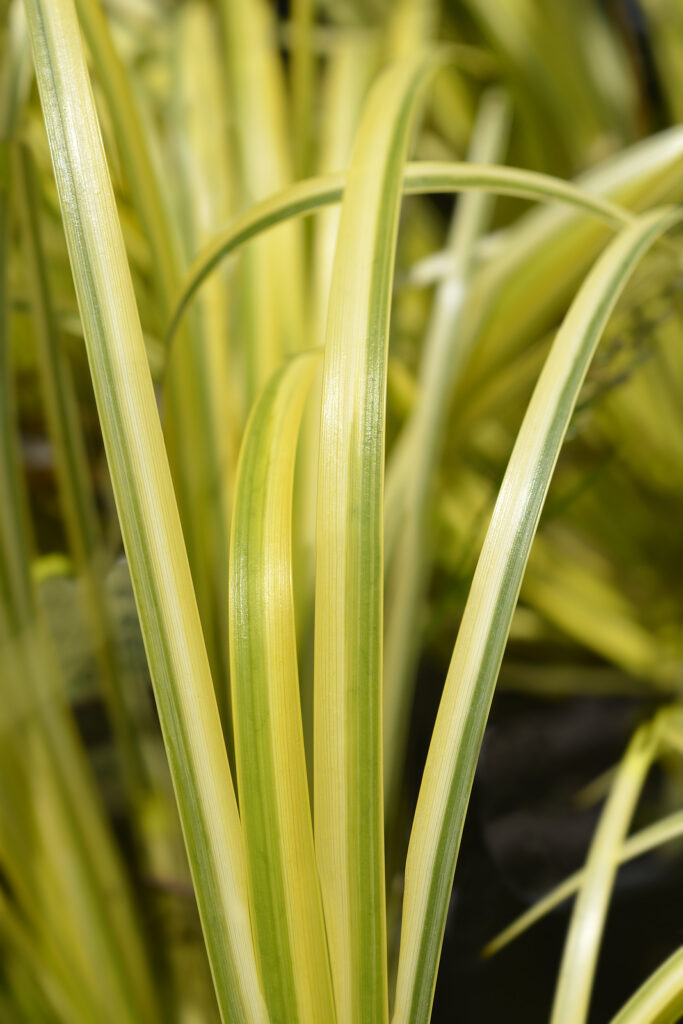Acorus, commonly called sweet flag–is a wetland perennial that is both grass-like and iris-like. It produces clumps of strap-shaped leaves and bears small nearly insignificant flowers that jut from leaf-like flower stalks.
Acorus grow from rhizomes. It grows best in wet soil or standing water. It is a colorful choice to grow the margins of ponds or bogs. Acorus spread steadily but is not invasive.
Acorus gets its common name “sweet flag” from its flag-like, iris-leaf-like leaves. It is more closely related to jack-in-the-pulpits (Asarum) than to flags or irises.
Acorus rhizomes can be dried and ground for use as a fixative in potpourri. The leaves, which have a slightly sweet, spicy fragrance, have been used as a strewing herb.
Acorus is a genus of 2 species of rhizomatous marginal aquatic perennials. They are native to shallow water and stream throughout the Northern Hemisphere, particularly East Asia.
Get to know Acorus
- Plant type: Perennial
- Growing zones and range: Zones 4 to 11
- Hardiness: Hardy to Zone 4; best in warm-winter zones
- Height and width: Size varies with species; A. calamus grows to 5 feet (1.5m) tall and 24 inches (60cm) wide; A. gramineus grow 3 to 14 inches (8-35cm) tall and 4 to 6 inches wide.
- Foliage: Clumps of strap-shaped or grasslike foliage that resemble miniature tufts of iris.
- Flowers: Flowers are inconspicuous and insignificant rounded or club-shaped; flowers are brownish green or white and jut out just below the tops of leaflike flower stalks.
- Bloom time: Midsummer
- Uses: Excellent foliage plant for shallow margins of pools, bog garden, or marshy areas.
- Common name: Sweet flag
- Botanical name: Acorus
- Family name: Araceae
- Origin: Native to Japan, northern Asia.
Where to plant Acorus
- Plant Acorus in full sun or partial shade.
- Plant Acorus in constantly moist or wet soil that is rich in organic matter.
- Acorus will grow in standing water.

When to plant Acorus
- Set Acorus outdoors in the garden in spring or autumn.
Planting and spacing Acorus
- Space Acorus 6 to 24 inches (15-60cm) apart.
How to water and feed Acorus
- Acorus want wet or very moist soil. Acorus thrives in shallow standing water.
- Fertilize Acorus with an all-purpose, liquid fertilizer in spring.
Acorus care
- Acorus spread steadily but generally aren’t invasive.
Growing Acorus as a houseplant
- Acorus gramineus is grown as a houseplant; grows 6 to 24 inches tall; ‘Variegatus’ has white-striped green leaves and grows to 12 inches tall.
- Give Acorus bright light, medium humidity, and a cool temperature.
- Keep the soil evenly moist to wet; if the soil dries out leaf tips will brown.
- Misting is not necessary.
- Check the soil daily for adequate moisture.
- Fertilize regularly in spring and summer.
Acorus pests and diseases
- Acorus is suceptible to wet and dry root rots as well as rust and several fungal leaf spots.
- Acorus can be damaged by red spider mites, especially in a hot, dry environment.
Acorus propagation
- Propagate Acorus by division in spring. Divide rhizomes at the beginning of the growing season. Pot division up and replant them once they are established.
- Divide Acorus every 3 to 4 years to keep the clumps vigorous and to contain their spread.
Acorus varieties to grow
- Acorus calamus. Sweet flag, Sweet calamus. Deciduous species grows to 5 feet tall and 2 feet wide; strap-shaped leaves are ¾-inch-wide. ‘Variegatus’ bears leaves striped lengthwise with cream and white. Plants grow with up to 6 inches of standing water over the rhizomes. Zones 4 to 11
- A. gramineus. Grassy-leaves sweet flag. Evergreen to semievergreen species with glossy, linear, grasslike leaves that form arching clumps to about 12 inches tall and wide. Plants grow with 1 to 2 inches of standing water over the rhizomes. Variegated and dwarf cultivars are available. Cultivars include: ‘Ogon’ has rich golden yellow leaves. ‘Pusillus’ is tiny, its green leaves seldom more than 1 inch long; used in miniature landscapes and dish gardens. ‘Veriegatus’, with white-edged, ¼-inch-wide leaves to 1 ½ feet long.



